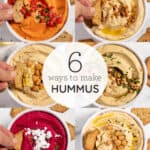How to make hummus 6 easy ways! This is my traditional recipe, plus six delicious variations packed with flavorful ingredients like roasted red peppers, beets, pesto, and more. Serve your favorite homemade hummus as a tasty dip, or make an appetizer spread with all six!
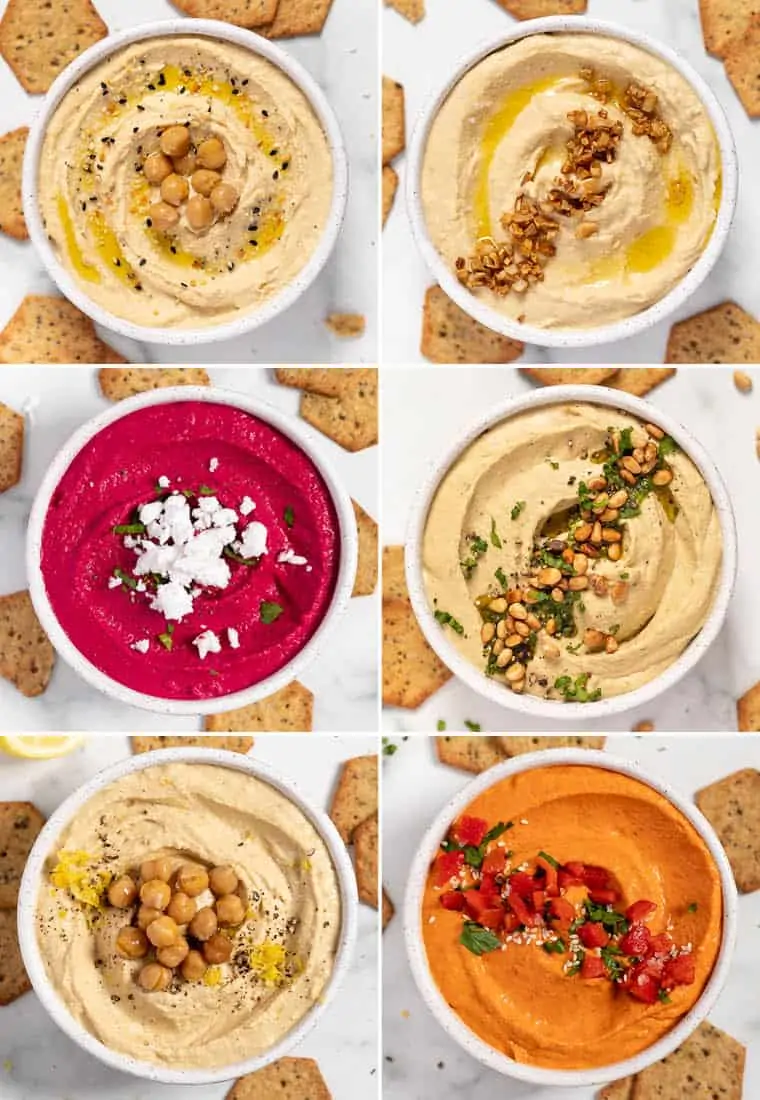
We're back with another one of my famous “6 Ways” posts. This time, it's all about one of my all-time favorite foods! Hummus is a creamy Middle Eastern dip or spread made from mostly chickpeas, tahini, lemon, and garlic. It's not only delicious, but super versatile. It's been a staple since I started my plant-based diet. I was eating so much hummus, I decided I might as well make it at home. And since variety is the spice of life, I have not one, but six delicious hummus recipes for you to try!
Why You'll Love This Homemade Hummus
- One recipe, six ways. I'll show you just how easy it is to make traditional hummus, plus tasty flavor variations including roasted garlic, beet and feta, pesto and pine nuts, lemon pepper, and roasted red pepper. These are just some of my favorites, but the possibilities are endless.
- Quick and SO easy. My recipe leaves the work to the blender. Make rich, creamy, flavorful homemade hummus in minutes! It's an awesome meal prep option, so I like to make a batch (or two) on a Sunday to enjoy all week long.
- Versatile. Hummus is a delicious dip for everything from crudités to pita bread, or you can use it as a spread, salad dressing, or creamy sauce. It goes with pretty much everything.

What You'll Need
My traditional hummus recipe needs only a handful of simple ingredients. From this basic recipe, you'll be able to make the easy variations in this post, plus any of your own homemade creations! I've included some notes on the classic ingredients below. You'll find the full recipes with amounts for each variation in the printable recipe card after the post.
- Chickpeas – You'll need cooked chickpeas, either the kind you buy in cans or you can boil them yourself.
- Tahini – Tahini is a paste made from ground sesame seeds. I've linked my homemade tahini recipe in the recipe card. Or, you'll find ready-to-use tahini in most grocery stores.
- Olive Oil – Not a traditional ingredient, but I find that it enhances the texture. I recommend using a good quality extra virgin olive oil or an alternative like avocado oil.
- Garlic – Freshly grated. In a pinch, you can substitute 1/4 to 1/2 teaspoon garlic powder per clove.
- Lemon – Freshly squeezed lemon juice is best. You can also zest the lemon before you juice it if you're making the lemon pepper hummus later on!
- Salt and Water
- Garnishes – I garnish my classic recipe with extra chickpeas, a little everything bagel seasoning, and a drizzle of olive oil.
Should I Remove the Skins From the Chickpeas?
Removing the chickpea skins isn't necessary for this recipe, but you can if you'd prefer an extra-creamy texture like you'll get in store-bought hummus. I rarely do it! However, it's totally up to you if you'd like to spend the extra time to remove the skins.
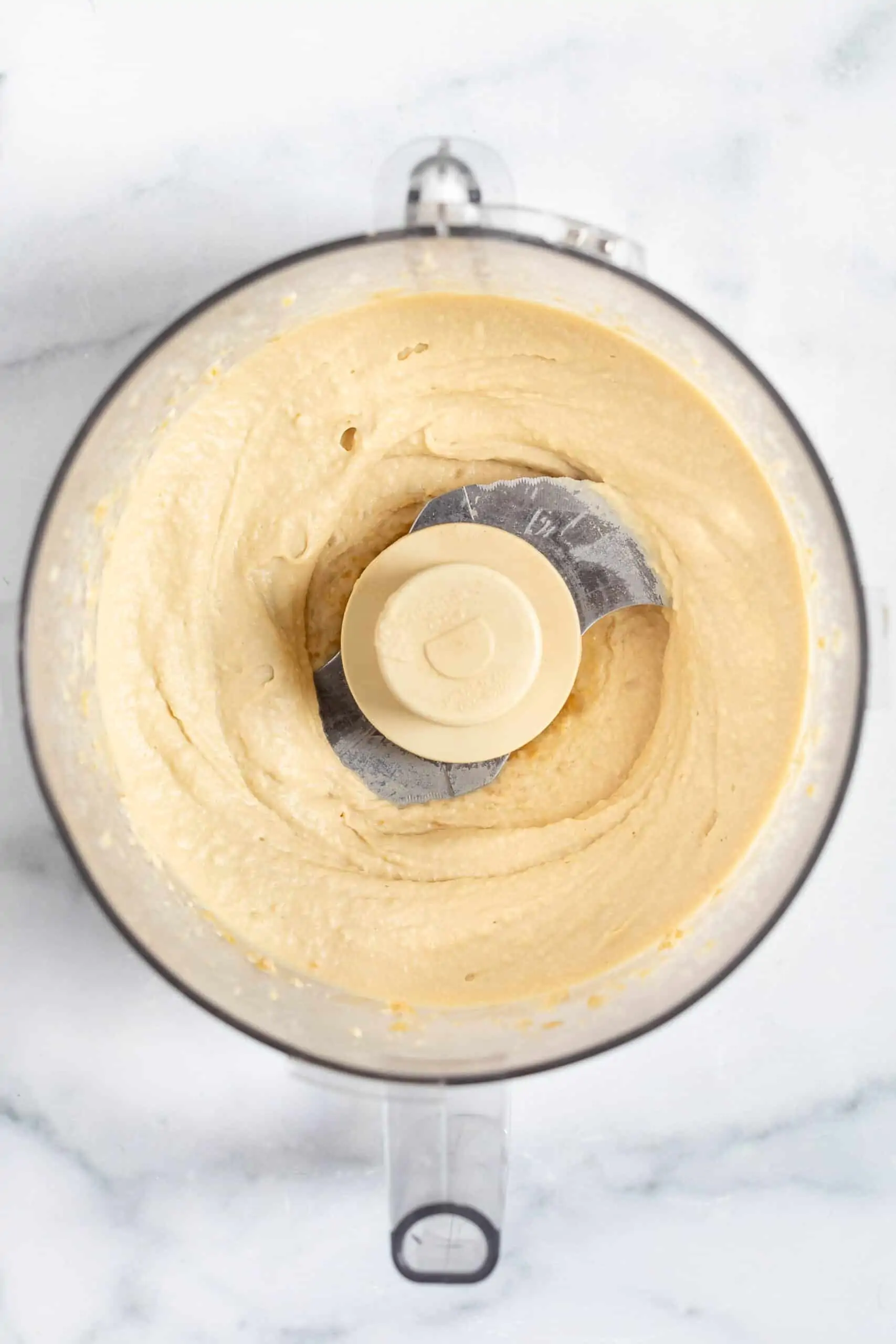
How to Make Hummus
There are many different ways to make hummus out there, but I've found the easiest is to use a food processor. It's ready to serve in minutes, no matter which flavor you choose. Let's start with how to make classic hummus. Then, use this same method to make all 5 delicious flavor options below. Scroll down to the recipe card for the printable recipe instructions.
- Combine the ingredients. Add your chickpeas, tahini, oil, and the rest of the ingredients to a food processor. Process on high until it's smooth and creamy. Then, while the processor is still running, stream in a little water until you reach your desired consistency.
- Store or serve. Transfer the finished dip to a bowl and add your garnishes for serving, or store it in a jar or an airtight container. Homemade hummus lasts for up to a week in the fridge.
5 Easy Flavor Variations
This easy homemade hummus is the ultimate blank slate. There are so many different flavors and variations you can try, and these are just a few of my best ones.
Roasted Garlic Hummus
- Blend your classic ingredients along with roasted garlic. Then, garnish the finished hummus with crispy garlic flakes, sea salt, and olive oil.
Lemon Pepper Hummus
- Combine and blend the hummus ingredients with freshly cracked black pepper and the juice from a whole lemon, plus lemon oil to boost the flavor. Garnish with chickpeas, lemon zest (zest the lemon before you juice it), extra cracked pepper, and salt.
Roasted Red Pepper Hummus
- Add roasted red peppers (see how to roast them in my roasted red pepper soup recipe) and smoked paprika. Garnish with chopped roasted peppers, parsley, and sesame seeds.
Pine Nut + Pesto Hummus
- Blend in toasted pine nuts and your favorite vegan pesto. Afterward, garnish with more pine nuts, a drizzle of pesto, fresh basil, and cracked pepper.
Beet Hummus
- Blend your ingredients with cooked beets (see my roasted root vegetables recipe), and garnish with crumbled vegan feta and fresh parsley.
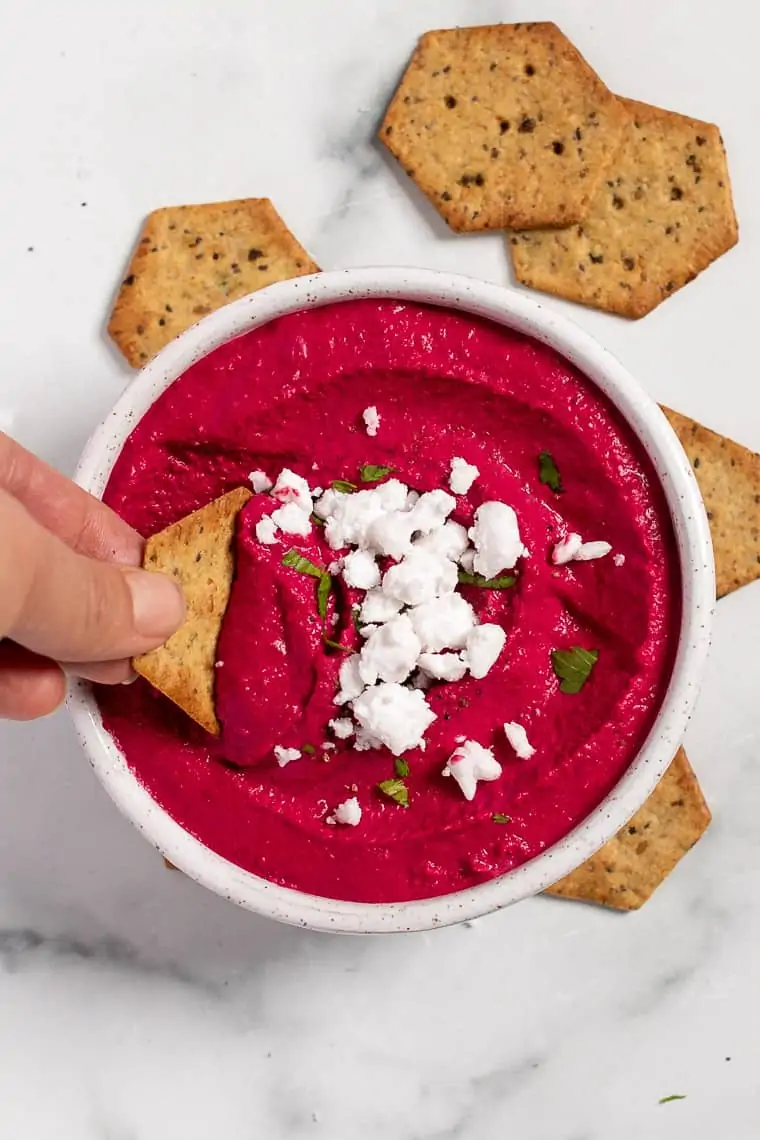
Serving Suggestions
Whether I'm serving it as an appetizer, for lunch, or assembling a platter for a party, I've yet to find an occasion that doesn't pair well with hummus! Here are some of my favorite ways to serve hummus that you can try, too:
- As a mayo replacement. Take any recipe that calls for mayo and swap it with your hummus flavor of choice. From sandwiches to potato salad and pasta salad, and more. It adds loads of flavor.
- As a dip. Hummus is great for dipping cut-up veggies, carrot sticks, or your favorite crackers. I'm always dipping these gluten-free quinoa crackers as a quick snack.
- At breakfast. I'm seriously obsessed with hummus on breakfast toasts. You can also use it as a spread for avocado toast.
- Sandwiches and wraps. I'll add hummus to my chicken lettuce wraps or these zucchini roll-ups and use it as a sandwich spread in bagel sandwiches. It's also delicious in a grilled cheese sandwich and black bean burgers.
- As a condiment. I love including hummus in Middle Eastern-inspired meals. I'll serve it with a variety of dishes like saffron quinoa salad and garnish the hummus with a little olive oil, lemon zest, and fresh herbs. Or, I'll use it in meal bowls, like these Mediterranean quinoa bowls.
- On a snack platter. If I'm having people over, a hummus board is always on my list. It's my meatless version of a charcuterie board!
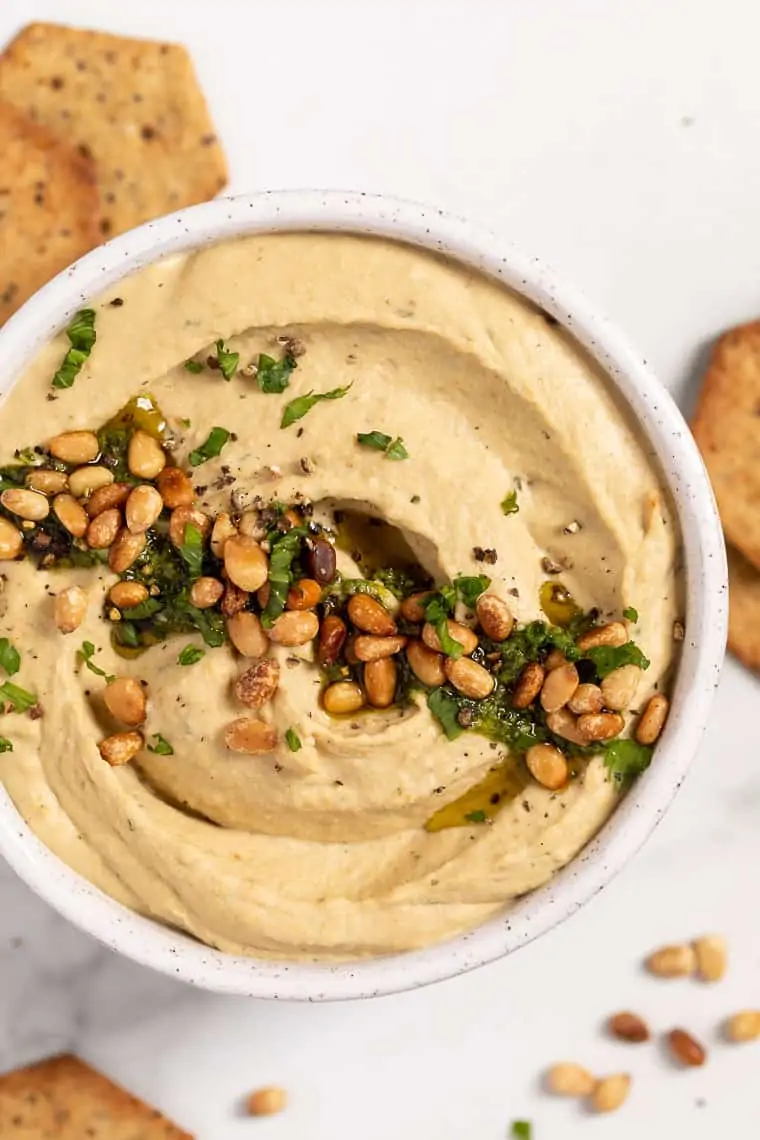
Frequently Asked Questions
Traditional hummus is vegan. It doesn't use any dairy, cheese, or other animal products and is suitable for anyone who follows a plant-based diet. That being said, if you're buying your hummus at the store, always make sure to check the ingredient labels just to be sure. Sometimes ingredients like yogurt can sneak in without you realizing it.
Since hummus is made from chickpeas, it's not keto as beans are high in carbs. However, I have seen keto hummus recipes that use a base of cauliflower instead of beans, like this keto paleo roasted cauliflower hummus from Wholesome Yum.
Most hummus is gluten-free, including this recipe, if the ingredients you use are certified gluten-free. However, some store-bought brands that are processed in the same facilities as other products might contain traces of gluten. If you have Celiac disease or a severe sensitivity, it's just one more reason to enjoy homemade hummus!
How to Store
- Refrigerate. Store your homemade hummus in an airtight container in the fridge for up to 7 days.
- Freeze it. Hummus can absolutely be frozen! Store in a sealed container for 3 – 6 months, thawing at room temperature when you're ready to consume it.
More Easy Dip Recipes
How to Make Hummus (6 Ways)
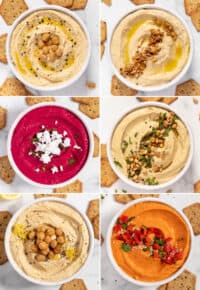
Ingredients
Traditional Hummus
- 1 1/2 cups cooked chickpeas
- 2 tablespoons tahini
- 2 tablespoons olive oil
- 1 garlic clove , grated
- Juice of 1/2 a lemon
- Generous pinch of salt
- 3 – 4 tablespoons water
- Garnishes: cooked chickpeas , everything bagel seasoning, drizzle of olive oil
Roasted Garlic Hummus
- 1 1/2 cups cooked chickpeas
- 2 tablespoons tahini
- 2 tablespoons olive oil
- 3 – 4 cloves of roasted garlic
- Juice of 1/2 a lemon
- Generous pinch of salt
- 3 – 4 tablespoons water
- Garnishes: crispy garlic , flaked sea salt, drizzle of olive oil
Lemon Pepper Hummus
- 1 1/2 cups cooked chickpeas
- 2 tablespoons tahini
- 2 tablespoons olive oil
- 1 tablespoon lemon zest (about 1 lemon)
- Juice of 1 lemon
- 1/2 teaspoon lemon oil (optional)
- 2 teaspoons fresh cracked pepper
- Generous pinch of salt
- 1 – 2 tablespoons water
- Garnishes: cooked chickpeas , lemon zest, cracked pepper, flaked sea salt
Roasted Red Pepper Hummus
- 1 cup cooked chickpeas
- 1/2 cup roasted red peppers (about 2 – 3)
- 2 tablespoons tahini
- 2 tablespoons olive oil
- 1 garlic clove , crushed
- Juice of 1/2 a lemon
- 1 teaspoon smoked paprika
- Generous pinch of salt
- 1 – 2 tablespoons water
- Garnishes: chopped roasted red pepper , chopped parsley, sesame seeds, flaked salt
Pine Nut + Pesto Hummus
- 1 1/4 cups cooked chickpeas
- 1/4 cup toasted pine nuts
- 2 tablespoons tahini
- 2 tablespoons olive oil
- 1 tablespoon vegan pesto
- Juice of 1/2 a lemon
- Generous pinch of salt
- 4 – 6 tablespoons water
- Garnishes: toasted pine nuts , pesto, fresh basil, cracked pepper
Beet Hummus
- 1 cups cooked chickpeas
- 1/2 cup cooked beets
- 2 tablespoons tahini
- 2 tablespoons olive oil
- Juice of 1/2 a lemon
- Generous pinch of salt
- 3 – 4 tablespoons water
- Garnishes: crumbled vegan feta , fresh parsley, cracked pepper
Instructions
- For all the varieties, simply add all the ingredients (minus the water) into a food processor. Process on high until smooth. With the processor running, add the water 1 tablespoon at a time until you've reached your desired consistency.
- Transfer the hummus into a bowl and top with the garnishes.
- Serve immediately with crackers, pita, toast, veggies, etc.
